Borghi nascosti: Montecchio tra tradizione e creatività
La tradizione dell'intreccio del vimini e l'innovazione della lavorazione del cuoio per farne oggetti inusuali. Montecchio riscrive il modo di essere borgo. Nel cuore dell'Umbria.
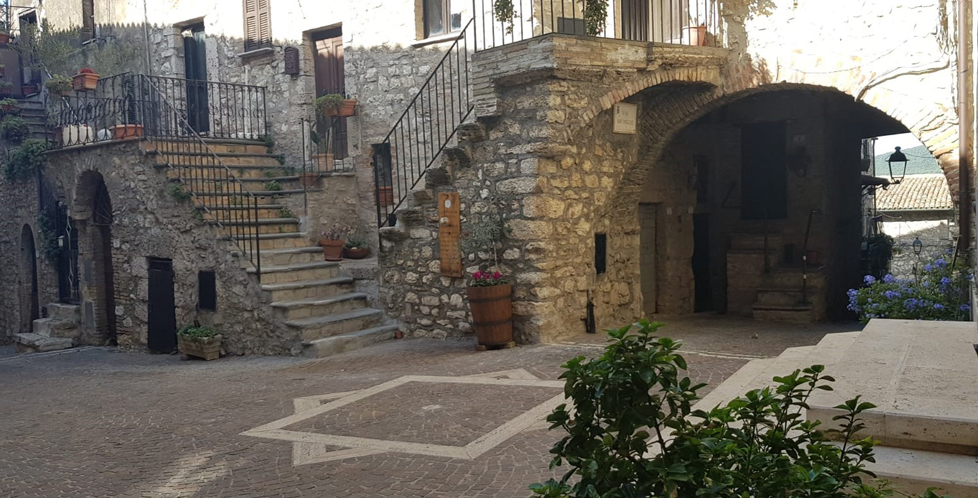
La tradizione dell'intreccio del vimini e l'innovazione della lavorazione del cuoio per farne oggetti inusuali. Montecchio riscrive il modo di essere borgo. Nel cuore dell'Umbria.

(English translation below)
Siamo in provincia di Terni, nel cuore dell’Umbria, tra i Monti Amerini e il lago di Corbara, tra gole e forre, tra rocce calcaree, pascoli e boschi. Nel Medioevo era chiamato Castro Monticoli, e a ricordare la sua struttura di castro fortificato restano le mura costruite tra il XII e il XIV secolo ed una alta torre. Sulla porta d’accesso è ancora situato lo stemma di Spoleto, che dominò su Montecchio a periodi alterni, contendendosela con Todi e Foligno.
Entrando nella cinta muraria si viene accolti da una ridente piazzetta, da cui si dirama poi un dedalo di viuzze con case costruite in pietra, dalla tonalità chiara, secondo l’urbanistica medievale. Scalette ardite e arcatelle ribassate disegnano gradevoli geometrie capaci di immergerci in un contesto medievale dal sapore autentico.
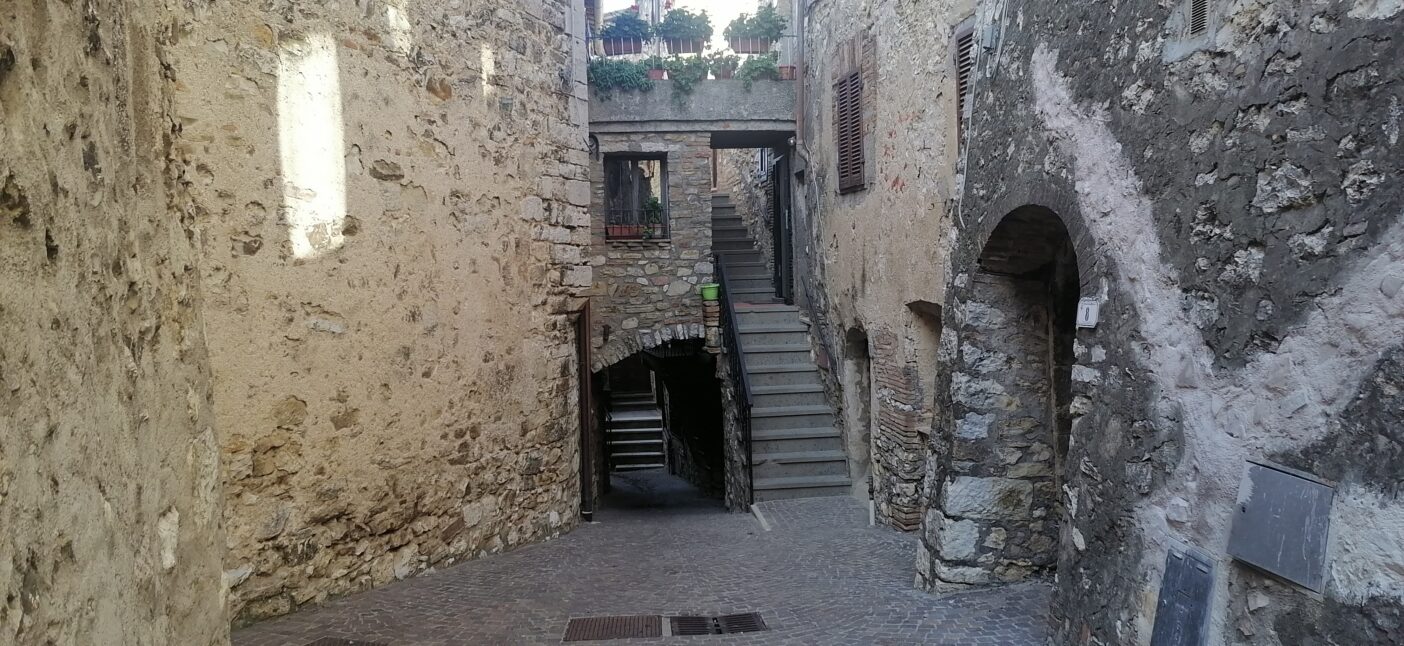
Ma le sue origini, ben più antiche, risalgono agli Etruschi, e di quella lontana epoca è testimonianza una bellissima necropoli che è possibile raggiungere anche a piedi dal paese. Si chiama la necropoli del Vallone di San Lorenzo, ed è una delle più vaste necropoli etrusche scoperte in Umbria.
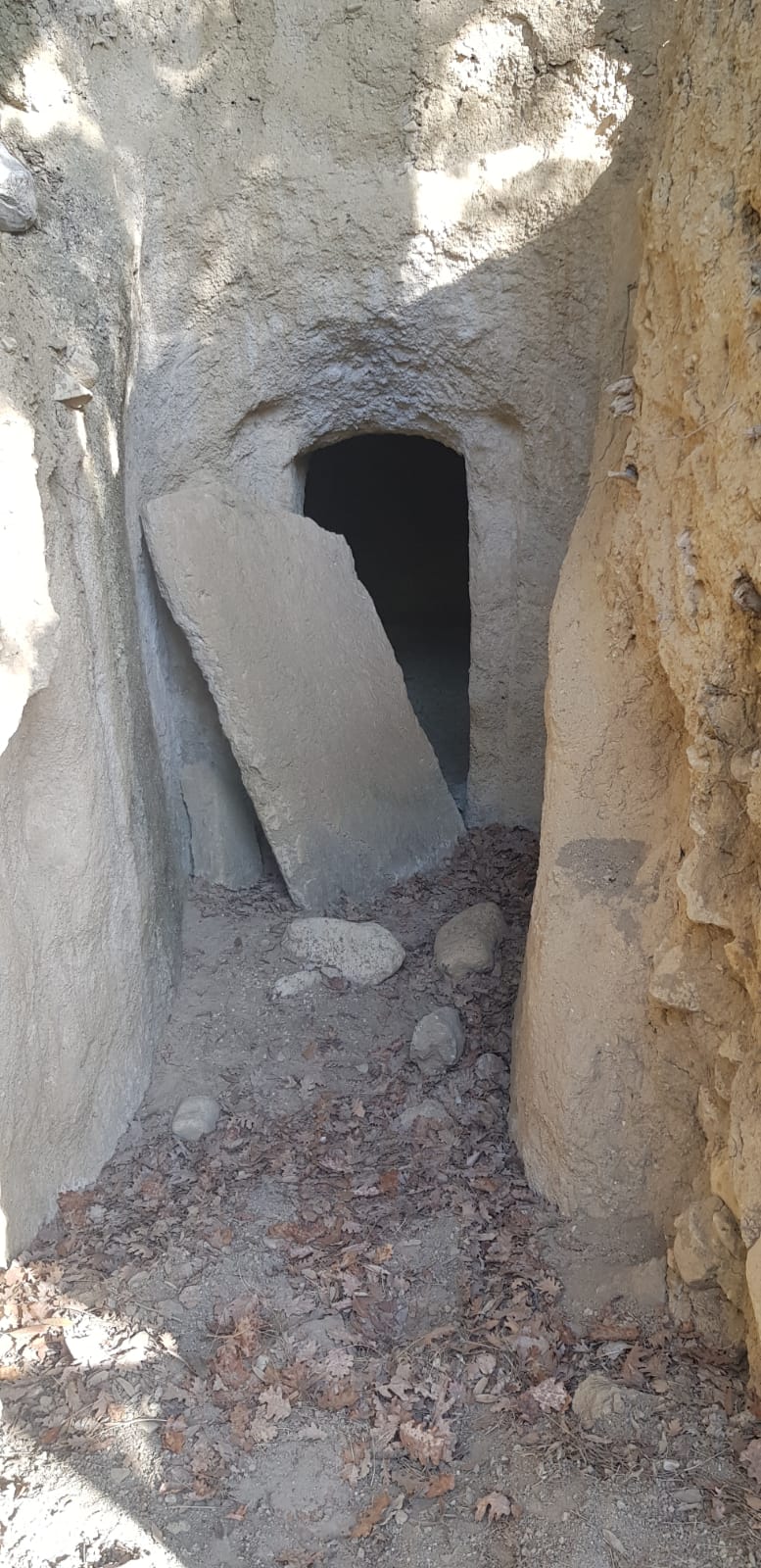
Qui le tombe sono scavate nella pietra e allineate le une alle altre seguendo una lunga successione in cui i dromos introducono alle camere funebri di forma quadrangolare con una banchina lungo il perimetro interno. In alcune tombe è ancora presente la grande porta di pietra usata per chiudere l’accesso al sepolcro.
La strada che conduce alla necropoli dal paese, di circa due chilometri e mezzo, è ricca di fascino, perché è una sterrata che attraversa un’alternanza di campi e di boschi.
Rientrati in paese ci si lascia sedurre dalle proposte gastronomiche della trattoria Kilometro Zero, dove il simpaticissimo ristoratore ci accoglie con un’esuberanza autentica, proponendoci piatti della gastronomia romana e umbra con incursioni tra mare e terra. Non stupitevi se vi propone qualche fuori menu, come è successo a me quando mi ha proposto uno spaghetto alle telline, arrivate fresche dal mare quella mattina grazie a un amico. Non mangiavo telline da anni, è stata un’esperienza evocativa. E’ così che ci si sente subito a casa, e vien voglia di attardarsi a tavola, complice la stanchezza dovuta al trekking fino alla necropoli.
Ma la sorpresa più entusiasmante è la scoperta di un’effervescenza artigianale nascosta tra gli stretti vicoli del borgo. Qui infatti ci imbattiamo in Cuoio Sonoro, un laboratorio artigiano creato da Ilaria Mingolla, una giovane creativa che ha unito la sua passione per la musica a quella per il disegno, inventandosi una bottega dove realizza manufatti in cuoio e pelle concepiti per il mondo dei musicisti e non solo.
Ilaria lavora il cuoio toscano a concia vegetale, che lei definisce una vera perla del made in Italy, sostenibile e naturale. Ogni singolo modello è disegnato, progettato, tagliato, tinto e decorato da lei stessa con tecnica di incisione a sbalzo, anche a più colori.
Il suo laboratorio è un vero incontro tra musica e scultura, dove ciascun cliente può anche proporre una sua personale idea da realizzare insieme. Il pezzo di punta sono le tracolle per strumenti musicali, concepite da chi prima di diventare una artigiana del cuoio era, e resta, una chitarrista, e che dunque conosce molto bene le esigenze di chi suona con la chitarra in spalla.
Non mancano poi zaini, portafogli, cinture e borse, ma se liberate lo sguardo tra gli oggetti esposti potete trovare tante altre idee originali, come eleganti collari per cani, guinzagli, battipenna per chitarra, sottobicchieri, portatabacco, tombolini per bici e persino custodie di cavetti usb.
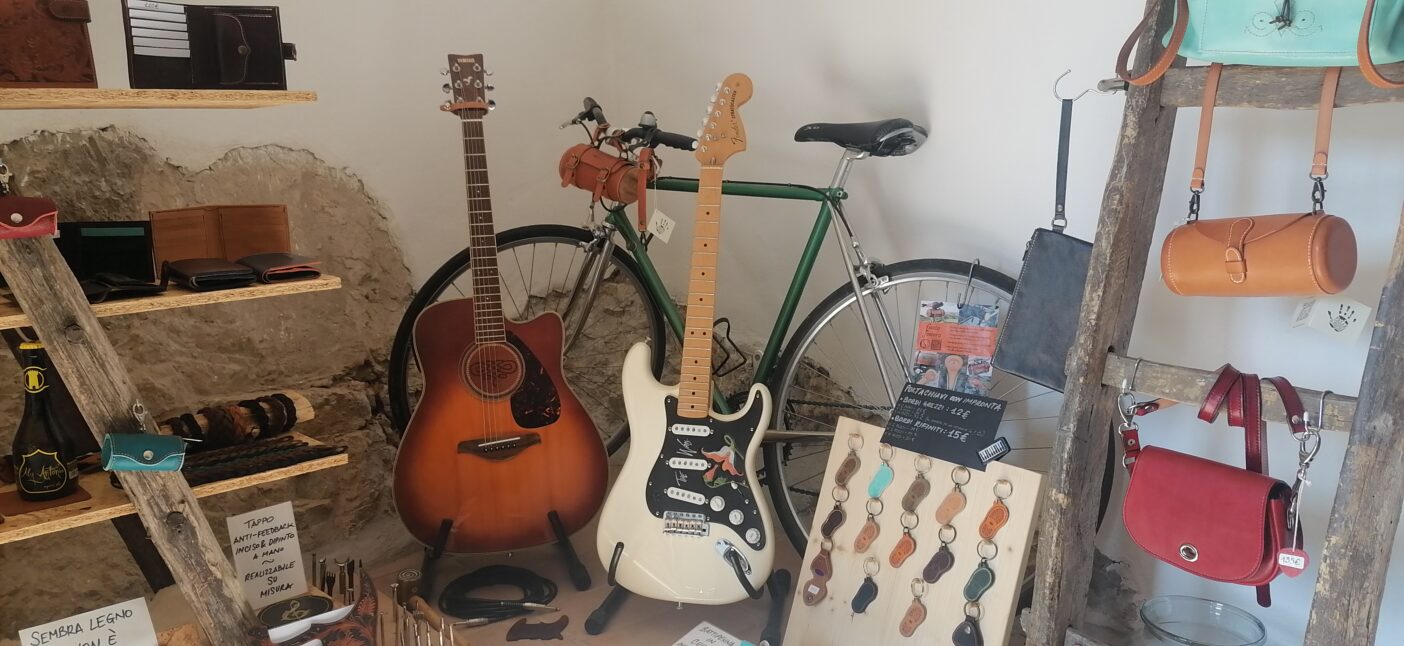
A pochi passi da Cuoio Sonoro c’è un’altra realtà artigianale pronta a sorprendere: è l’Arte dell’intreccio, dove David e Andreina realizzano, con talento, esperienza e cura, cesti di vimini e altri numerosi oggetti intrecciati a mano secondo l’antica arte tradizionale del territorio umbro.
Lasciatevi ammaliare dal modo in cui Andreina intreccia la treccia celtica spiegando la storia di questo semplice amuleto che era usato dai pellegrini per scacciare i guai. Un intreccio che nasce da un unico movimento per creare una spirale.
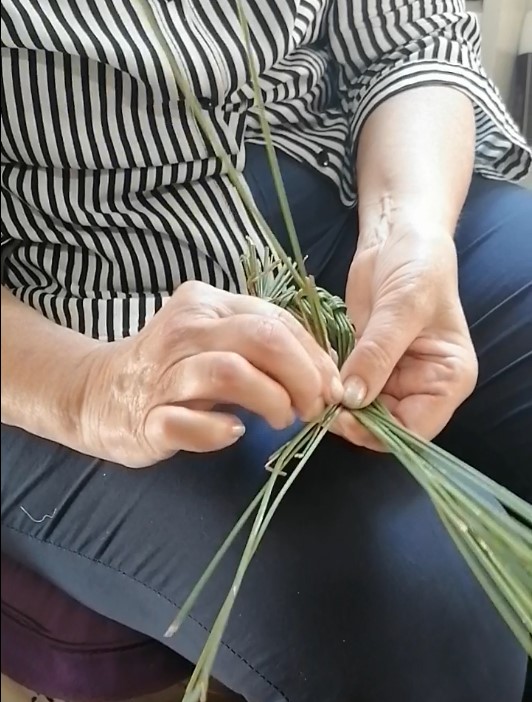
Qui David propone anche la sua idea di presepe, creato dentro grandi funghi a mensola come se ne vedono tanti nei boschi del centro Italia. Questi presepi hanno un che di magico, inseriti all’interno di questi grandi funghi e decorati con ogni dettaglio, dal muschio alle luci, per diventare singole opere d’arte in cui i pastori, con abiti rigorosamente in tessuto, sembrano vivere di vita propria. Ciascun presepe è unico, proprio perché creato all’interno di un singolo fungo gigante diverso da tutti gli altri. Non perdete l’occasione di comprarne uno, vi resterà per sempre.
E non perdete l’occasione di visitare Montecchio, per lasciarvi stupire dalla autenticità di questo borgo incastonato nella valle del Tevere.
INFO PRATICHE:
Trattoria Kilometro Zero: via Alessandro degli Atti 1, Montecchio. Tel. 0744 951275 –
Cuoio Sonoro: piazza della Porta Nuova 7, Montecchio. Tel. 380 3407511 – cuoiosonoro@hotmail.com
Arte dell’Intreccio, piazza della Porta Nuova 6, Montecchio. Tel. 338 6328225 – 391 1773990 – artedellintreccio@gmail.com
ENGLISH VERSION
The tradition of wicker weaving and the innovation of leather processing to make unusual objects. Montecchio rewrites the way of being a village. In the heart of Umbria.
We are in the province of Terni, in the heart of Umbria, between the Amerini Mountains and Lake Corbara, between gorges and canyons, between limestone rocks, pastures, and woods. In the Middle Ages it was called Castro Monticoli, and the walls built between the 12th and 14th centuries and a high tower remain to remember its fortified castro structure. The coat of arms of Spoleto is still located on the entrance door, Spoleto dominated Montecchio in alternating periods, competing with Todi and Foligno.
Upon entering the city walls you are greeted by a charming little square, from which a maze of narrow streets branches off with houses built in light-colored stone, according to medieval urban planning. Bold ladders and low arches design pleasant geometries capable of immersing us in a medieval context with an authentic flavour.
But its much older origins date back to the Etruscans, and a beautiful necropolis which can also be reached on foot from the town bears witness to that distant era. It is called the necropolis of the Vallone di San Lorenzo, and it is one of the largest Etruscan necropolises discovered in Umbria.
Here the tombs are dug into the stone and aligned with each other following a long succession in which the dromos lead to the quadrangular funeral chambers with a platform along the internal perimeter. In some tombs, the large stone door used to close access to the tomb is still present.
The road that leads to the necropolis from the town, about two and a half kilometers long, is full of charm because it is a dirt road that crosses alternating fields and woods.
Once back in the village, we let ourselves be seduced by the gastronomic offerings of the Kilometro Zero restaurant, where the very friendly restaurateur welcomes us with authentic exuberance, offering us dishes from Roman and Umbrian gastronomy with forays between sea and land. Don’t be surprised if he offers you something off the menu, as happened to me when he offered me spaghetti with clams, which arrived fresh from the sea that morning thanks to a friend. I hadn’t eaten cockles for years, it was an evocative experience. This is how you immediately feel at home, and you want to linger at the table, thanks to the tiredness caused by the trek to the necropolis.
But the most exciting surprise is the discovery of an artisanal effervescence hidden among the narrow alleys of the village. In fact, here we come across Cuoio Sonoro, an artisan workshop created by Ilaria Mingolla, a young creative woman who combined her passion for music with that for drawing, inventing a workshop where she creates leather and leather artefacts designed for the world of musicians and not only.
Ilaria works with vegetable-tanned Tuscan leather, which she defines as a true pearl of Made in Italy, sustainable and natural. Every single model is designed, cut, dyed, and decorated by herself with an embossed engraving technique, even in multiple colors.
Her laboratory is a true meeting between music and sculpture, where each client can also propose his personal idea to realize together. The flagship piece are the straps for musical instruments, designed by someone who before becoming a leather craftsman was, and remains, a guitarist, and who therefore knows very well the needs of those who play with the guitar on their shoulders.
There is also no shortage of backpacks, wallets, belts, and bags, but if you look freely among the objects on display you can find many other original ideas, such as elegant dog collars, leashes, guitar pickguards, coasters, tobacco holders, bicycle totes and even cases for USB cables.
A few steps from Cuoio Sonoro there is another artisan reality ready to surprise: it is the Art of weaving, where David and Andreina create, with talent, experience and care, wicker baskets and numerous other hand-woven objects according to the ancient traditional art of the Umbrian territory.
Let yourself be enchanted by the way Andreina weaves the Celtic braid explaining the history of this simple amulet which was used by pilgrims to ward off trouble. An intertwining that arises from a single movement to create a spiral.
Here David also proposes his idea of a nativity scene, created inside large shelf mushrooms like many can be seen in the woods of central Italy. These nativity scenes have something magical about them, inserted inside these large mushrooms and decorated with every detail, from moss to lights, to become individual works of art in which the shepherds, with strictly fabric clothes, seem to live a life of their own. Each nativity scene is unique, precisely because it was created inside a single giant mushroom different from all the others. Don’t miss the opportunity to buy one, it will stay with you forever.
And don’t miss the opportunity to visit Montecchio, to be amazed by the authenticity of this village nestled in the Tiber valley.
